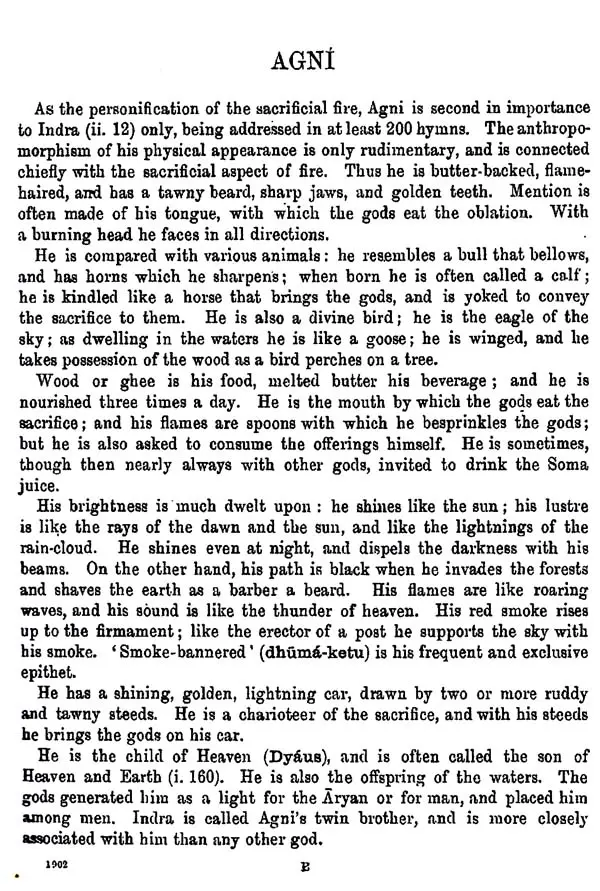About the Book This book contains thirty hymns selected from the Rgveda primarily for students who while acquainted with classical sanskrit are beginners of vedic lacking the aid of a teacher with adequate knowledge of the earliest period of the language and literature of India. In conjunction with the author's Vedic Grammar the reader aims at supplying all that is required for the complete understanding of the selections. A copious index has been added for the purpose of enabling the student of utilize to the full the summary of Vedic Philosophy which this book contains.
About the Author Macdonell was born at Muzaffarpur in the Tirhut region of the state of Bihar in British India, He was educated at Göttingen University, then matriculated in 1876 at Corpus Christi College, Oxford, gaining a classical exhibition and three scholarships (for German, Chinese, and the Boden Scholarship for Sanskrit). He graduated with classical honours in 1880 and was appointed Taylorian Teacher of German (language) at Oxford. In 1883 he obtained his PhD from the University of Leipzig, and then became Deputy Professor of Sanskrit at Oxford in 1888, and Boden Professor of Sanskrit in 1899 (a post that carried with it a fellowship of Balliol College, Oxford). Macdonell edited various Sanskrit texts, wrote a grammar, compiled a dictionary, and published a Vedic grammar, a Vedic Reader, and a work on Vedic mythology; he also wrote a history of Sanskrit.
Preface This Reader is meant to be a companion volume to my Vedic Grammar for Students. It contains thirty hymns comprising just under 300 stanzas. Theso hymns have been taken exclusively from the Rigveda, not only because that Veda represents the earliest and most important phase of the sacred language and literature of India, but because the addition of specimens from the later Vedic literature with their divergences in speech and thought would tend to confuse the learner beginning the study of the oldest period. All the books of the Rigveda have been drawn upon except the ninth. The reason of this exception is that, though the whole of the ninth book. practically consists of hymns addressed to Soma only, the hymn which in my opinion represents that deity best occurs in another (the eighth) book. All the most important metres are represented, though no specimens of the rare and complex strophic measures could be given because none of the hymns composed in them seemed to be suitable for the Reader. I have also considered literary merit as far as possible in making the selection. As regards subject-matter, each of the more important deities is represented by one hymn, Agni alone by two. There are besides a few hymns of a different type. One is concerned with social life (x. 34), one with magical ideas (vii. 103), two with cosmogony (x. 90. 129), and three with eschatology (x. 14. 15. 135). The selection thus forms a brief epitome of the Rigveda, the earliest monument of Indian thought. The arrange- ment of the hymns follows their order in the text of the Rigveda as shown, together with their respective deities and subjects, in the table of contents (p. ix). As the latter list is so short, the name of the deity addressed in any selected hymn can be found at once, but it also appears in its alphabetical order in the General Index.
Unlike all Sanskrit and Vedic chrestomathies known to me, the present work is intended primarily for students who, while acquainted with Classical Sanskrit, are beginners of Vedic lacking the aid of a teacher with an adequate knowledge of the earliest period of the language and literature of India. It will moreover, I think, be found to contain much detailed information useful even to more advanced students. Hence difficult and obscure stanzas have never been omitted from any of the selected hymns, because the notos here afford an opportunity of illustrating the methods of critical interpre tation (see, for instance, pages 36, 47, 139-40, 152, 166, 175).
In conjunction with my Vedic Grammar for Students, the Reader aims at supplying all that is required for the complete understanding of the selections without reference to any other book. Each hymn is preceded by a special introduction describing briefly the deity or the subject with which it deals. The text of every stanza is printed in three different forms. The first is the Samhita text, in Devanagart characters, exactly as handed down by tradition, without change or emendation. But each Pada or metrical line is printed separately so as to exhibit to the eye the versification of the stanza. Then comes on the right half of the page the traditional Pada text in which each word of the Samhita text is given separately without Sandhi, and in which compounds and certain derivatives and case- forms are analysed. This is an important addition because the Pada text, as nearly contemporary in origin with the Samhita text, fur nishes us with the earliest interpretations, within the sphere of phonetics and word-formation, of the Rigveds. Next follows the transliterated Samhita text, in which by the removal of vowel contractions, the resolution of semivowels, and the replacement of a, the original metre of the Rigveda is restored and, by the use of punctuation, the sense is made clearer.
**Contents and Sample Pages**






















